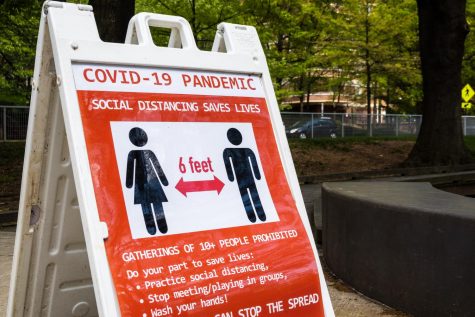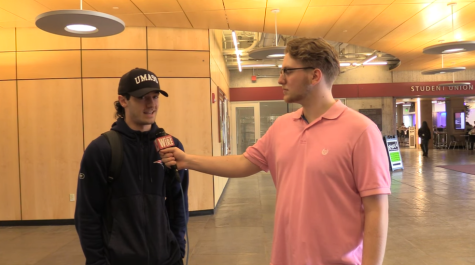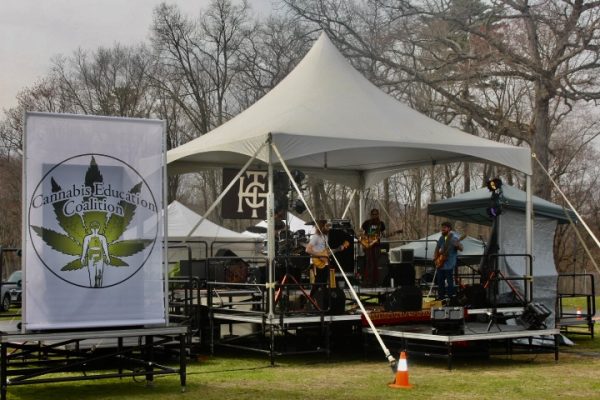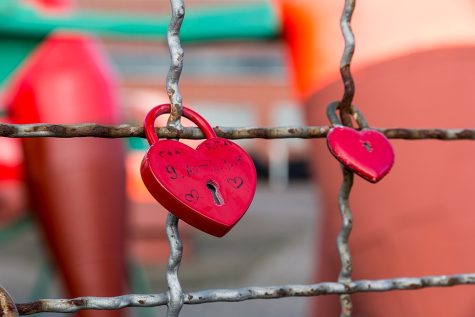Looking Back: Corona lungs, pandemic time warp and Zoom University
Three students reflect on life the past year during the coronavirus pandemic
Editor’s note: The following stories are the first part of Looking Back, a two-part series of first-person blog posts looking back at life the past year. The series is produced by Professor Steve Fox’s Journalism 300 course in the Journalism Department at UMass Amherst.

Corona lungs
By Jess Galvin
This has been a year for the history books for sure. The coronavirus shut down the country last March and here I am sitting on a plane with a mask over my face a year later. When the virus first hit, I was thinking it would only last until summer and everything would be back to normal once everyone just stayed inside for a month or two. Wow, was I optimistic!
The start of quarantine, although I was sent home for the rest of my last month of freshman year, was when I was least affected by the virus. Once summer came along and my summer job at a local summer camp was cancelled, I then realized how real this pandemic was getting. I then learned that I was going to be online for most likely my entire sophomore year of college, and that really didn’t sit well with me. Luckily, I was able to snag an apartment with my friends off campus so I would at least be able to live somewhat of a normal college year.
The top story I will be telling my kids about this terrible year will have to be when I experienced the virus first-hand. In late September, Amherst had their first breakout of cases amounting to 13 in total. And yes, one of those 13 was in fact me. I found out on a Tuesday night that my friends’ girlfriend had just tested positive and I had just been in close contact with them along with my other friends who had shared a drink with her a few nights before. So ultimately, I knew I was done for.
The next morning, I woke up to get tested and immediately thought ‘uh oh’. I was so unbelievably tired it was a struggle just to get out of my bed. I was also experiencing a not so pleasant headache along with back aches. The next day when I got the positive result was even worse, with chills and hot flashes every 10 minutes and a temperature reaching almost 102.0. The strangest symptom I noticed that day was an itchy, red rash on the back of both my legs. I found out this was uncommon but normal symptom, but I still had a brief moment where my dramatic self thought, ‘yup this is it.’
Since my roommate was still negative, I packed up my things and moved in with my two guy friends who were also positive for the two-week quarantine (who I am also convinced are the culprits that gave it to me). This definitely made the not-so-fun-experience at least somewhat fun; I was basically a guy for two weeks and I loved it. All we did was order Hot Table sandwiches through Door Dash, play 2K, and binge watch “The Office.” Occasionally, we’d see how many jumping jacks we could do that day without feeling as though our lungs would give out. I never got above five (and no I’m not kidding).
Even months after my quarantine, I was still experiencing an awful amount of shortness of breath and couldn’t even put away laundry without having to catch my breath. Many times, I would be out of breath walking upstairs behind my friends and they’d turn around to make sure I wasn’t dying. My go-to saying was, “it’s just the corona lungs.”
Thankfully, I can finally feel those lasting affects slowly go away. Now I put away my laundry without having to pause and breathe every minute!
If there’s one thing to learn from this whole experience, it is to always choose the All-Time Lakers Team when playing 2K, and also don’t start eating Hot Table or else you’ll find yourself there four times a week ordering a medium southwest chicken sandwich.
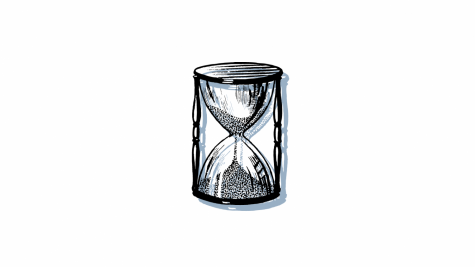
Life in the pandemic time warp
By Catherine Hurley
“Who knew that a year could be this long.” That statement is a summation of what we’ve all been through, an exhausting, devastating, seemingly never-ending journey through the COVID-19 pandemic, but it’s also a genuine question. Before this, I had no idea how long a year usually is.
My concept of time used to revolve around school. September through June was a year; July and August were an addendum. And this mindset worked for me. There was no need to sit and contemplate the passage of time because something new was always coming next. This year, however, reframed my thinking about what a year looks like and how long it can take to pass. A year, from March to March, devoid of the structure that used to define my life.
On March 13, 2020, I woke up to my roommate frantically packing up her belongings.
“Are you really taking everything?” I asked. “You’ll have to bring it back in three weeks anyway.”
It turns out she was right. I boarded a cramped bus in Amherst with a bag that held only a week’s worth of clothes. Later on, I stood in line at the filthy McDonald’s in South Station and waited in a maskless crowd for my train home. One year later, I’m still here.
I know that I’m not the only one struggling to remember what I did or how I’ve felt this year. Countless articles muse on pandemic burnout, the passage of time, and the sharp increase in people’s feelings of anxiety and depression, but they feel naive, even if written just a few months ago.
In September, The Washington Post marked six months since the beginning of the pandemic with an article that highlights a collective loss of time. It successfully encompassed the grief felt as the United States reached 200,000 deaths from COVID-19. But how are we supposed to relate to the sentiment when six months later the death toll has more than doubled?
Memories from last spring feel horribly out of touch with our present reality, but they’re a helpful reminder of where we began. The “Imagine” video came out slightly more than a year ago. The time in between is what a year without school, structure and interaction feels like.
I’m lucky to not have suffered any major losses this year, like a job or family member, so I’m able to see a couple of slivers of hope. For one, this experience has felt like a test drive for the rest of my life, one that doesn’t revolve around an academic calendar. If I ever find myself working from home, I’ll know how to create a routine and spread out the monotony of the day.
Light is beginning to come from this endless tunnel. Easter on Zoom, which once felt like a novelty, will be replaced by a small, outdoor, masked gathering this year. Tomorrow, I’ll get the first dose of the vaccine. As we continue through the second year of pandemic-altered life, I hope to recognize positive milestones and appreciate regaining parts of normal life, even if I don’t know what day it is.

Zoom University v. Motivation
By Kaci Madden
In January of last year, if someone had told me that in two months we would be sent home from school and attending classes through our laptop screens, I most definitely wouldn’t have believed you. Looking back to when the pandemic started getting worse in early March of 2020, rumors were circulating around UMass about whether we were going to have to leave campus, and that idea seemed crazy to me. It all seemed so surreal, and never having experienced a pandemic before, I wasn’t able to wrap my mind around how deeply this would soon affect the future for not only myself but for everyone across the globe.
At first, I assumed getting sent home from school could be nice in a way, and to be honest there was a little hope in me that classes might get cancelled all together. Instead, we were forced to attend class through Zoom, which turned out to not be as simple as it sounds.
Personally, along with many others I know of, I found it difficult to find the same motivation at home that I had for school while on campus. In an op-ed for Pelham Memorial High School’s newspaper The Pel Mel, Caroline Michailoff described how online learning has impacted students. “From an online survey done among 100 high school students,” wrote Michailoff, “it was found that motivation has gone down by at least 30% this school year.” Once COVID-19 changed things, there was no more grabbing coffee and breakfast at the dining hall on the way to class, no more studying with friends, but being forced to isolate and figure everything out on my own. I think a big part of being a freshman in college is learning to be comfortable with doing things by yourself, and I definitely improved at this after being forced to isolate for months on end. I really had to dig deep within myself in order to regain my motivation to do my schoolwork despite being cooped up in my house. “The lack of a physical space to designate as a work zone like the classroom once offered can leave one with a lack of focus, due to the many distractions that can come in an average household,” wrote Sean Turner in an article for Granite Bay Today. Having a designated space(s) to do schoolwork definitely has been key in keeping me on track, and even getting out of the house to do work when possible helps me tap more into my motivation.
Since school has been remote for about a year now, my time management skills have actually greatly improved whereas they definitely struggled before the pandemic. Making to-do lists for myself and physically writing down the work I need to get done has saved me. It’s also important to write down the work you need to accomplish because “there is a limit to how much information you can recall and process at one time,” wrote Ryan Korstange in his article for The Conversation. Without making a concrete schedule and holding yourself accountable, sometimes it’s pretty tricky to get out of bed in the morning and pull up Zoom. Although COVID-19 has brought about challenging times for everyone, at least many of us are learning to dig deep within ourselves to find that same motivation that we once had when in-person classes were in session.

